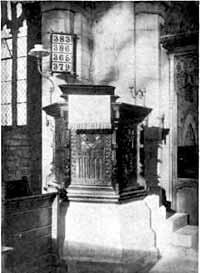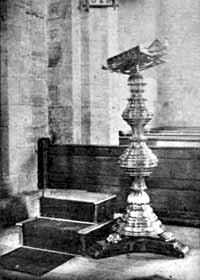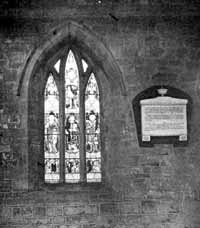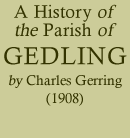< Previous | Contents | Next >
The Church contains only one incised alabaster slab, lying near the south end of the altar (see note), and two sculptured ones. The older of these two lies at the north side of the chancel, near the altar, which is shewn in "Throsby's edition of Thoroton," vol. 3, plate at page 30, figure 1.
Note.—In 1887, Mr. A. E. Lawson Lowe, F.S.A., Shirenewton Hall, near Chepstow, contributed the following article to the "Local Notes and Queries" of the Nottinghamshire Guardian, with regard to the incised slab just referred to:—

"Brief mention is made of an alabaster slab, with the feet of an effigy and some part of an inscription. This appears to merit a somewhat more particular description. It belongs to that specially interesting class of memorials, commonly known as incised slabs, the designs upon which were formed by lines incised in alabaster or in some soft kind of stone, the lines being rendered more conspicuous by some black composition with which they were filled. This particular slab seems to have originally borne a representation of a man in plate armour, and had an inscription in what is known as "black letter," within double lines, running round the edge of the slab. Of the effigy itself nothing but the lower part of the legs and the broad sabbatons that formed the defence of the feet remain. The whole of the incising on the upper part of the slab has been completely worn away, and merely a portion of the original inscription along the bottom of the slab is visible. Even this is very imperfect, but a few years ago the date "MCCCCLXXXVII," which evidently formed the conclusion of the inscription, was plainly visible. The broad sabbatons would certainly appear to indicate a somewhat later period, but the date is, or was, too clear and distinct to admit of any question. I should perhaps mention that my notes were made in Gedling Church in 1870, and some other in my possession, made at Gedling by an antiquarian friend three or four years later, are precisely the same in this particular. It will be remembered that in 1487 was the memorable battle of Stoke, near Newark, and it is possible that the armed effigy upon this slab may have represented some personage who fell on that bloody field. It is a somewhat remarkable fact that Francis Viscount Lovel, one of the leaders of the rebel army at the battle of Stoke, whose fate is enshrouded in so much mystery, was, in right of his mother, lord of the manor of Gedling, which lordship was escheated on his attainder. It is hardly likely, however, that any memorial of this unhappy nobleman would have been placed in Gedling Church, and still less likely that, had such been the case, it would have escaped notice. Thoroton makes no mention whatever of the slab."
The slab is of Mansfield stone, the edges are moulded with a cavetto, and round; the sculpture is Twelfth Century work, rudely cut in very low relief, all of it being worked below the surface of the slab. The effigy is that of an Ecclesiastic, clad in alb and dalmatic, over his left shoulder he wears a stole, the head is tonsured, and the hands are crossed downwards in prayer. It is said that there is an empty sarcophagus immediately underneath the slab. The other, slab is against the Tower arch, just outside the vestry. It was found with its sarcophagus in 1872, at the east end of the north aisle, and contained 6 or 9 skulls. On the slab is a long floriated cross. The head of a male shows through the middle of the head of the cross, and the feet through a trefoil at the foot; there are no traces of a chalice. A faint outline of the tonsure suggests that it was intended for an ecclesiastic (circa 1330).
The uppermost step of the tower stairs is part of an old sepulchral slab. The head of a loop-hole of the tower stairs is formed with a slab bearing an incised cross, late 13th century.
In the chancel are five mural tablets:—
1. Richard Wood, M.A., 30 years Rector of Gedling, prebendary of Lichfield and Southwell, died 7th October, 1734, aged 70 years; and Bridget, his sister, who died 12th November, 1714, aged 56 years.
2. William Smelt, 39 years Rector, born 7th May, 1745, died 22nd August, 1823.
3. Charles Williams, A.M., 34 years Rector of Gedling, died 24th July, 1866, aged 81 years. His wife, Charlotte, who died 25th August, 1849, aged 56; and his sister, Elizabeth, who died nth April, 1840, aged 60.
4. Everilde Beaumont, died 16th December, 1848, aged 48.
5. Brass plate. William Stanford Burnside, Esq., of Gedling and Plumtree, co. Nottingham, died 22nd May, 1870, aged 79, and Mary, his wife, who died 1st March, 1870, aged 75.
There is a floor-slab to Richard Kirkby, Rector, presented in 1745, died 10th February, 1784, aged 68; and his wife, Anne, died 26th December, 1784.

The Font.
The Font is in the west end of the south aisle, near the door, it is very plain and poor, comparatively modern; the steps are of alabaster.
The Church Prayer Book was published at Oxford in 1844, is folio size, and bound in red morocco leather, with decorated gilt sides, and bears the Stanhope arms, surmounted by an Earl's coronet.
A fine and sweet-toned Organ, two manual, with 18 stops, is in the chancel, built by Forster and Andrews, of Hull, and was presented to Gedling Church, in 1874, by William Elliot Burnside, Esq., of Gedling, in memory of his grandparents.
It was the custom at Gedling Church, until 1870, for the congregation, when singing, to turn and face the organ, which was in a gallery at the west end.
The Rector has kindly contributed the following note:—
"A history of Gedling would be incomplete without reference to the music at the Parish Church.
When the organ was in a gallery under the west window the congregation must have produced a notable Choir; if we may judge from the collection of anthems, by Handel, Boyce, and Croft, presented by the Earl of Chesterfield in 1795.
The present organ, a gift of W. Elliot Burnside, Esq., was originally in the north aisle, for which it was built. It is a very sweet-toned instrument, of which the parishioners are justly proud, as they have been ever grateful to the donor. It now stands in the chancel. It was moved there about the time that the popular musical services rendered annually at the Lying in Charity were given up.
In 1887 a surpliced choir was introduced. The mixed choir then ceased to exist. But the tradition of the Gedling Choir was efficiently maintained on the voluntary principle; and it has since been even surpassed.
During the last eight years, the author of our History, supported by a talented organist and many good voices, has trained the choir with unusual musical success. It affords all the help the congregation can reasonably expect towards lifting their hearts to sing the praises of the Lord. As the years roll by it will be a subject of congratulation to all who love the old Church and pray for the growth and prosperity of the Faith, if the congregation of the time is seen to take up the habits of regularity and punctuality of the present choir, and to catch the spirit of untiring energy and devotion belonging to our able Choir Master."
A. E. B.
Over the Altar is a fine painting, framed in pitch pine, the subject being "The Descent from the Cross," said to be by Jouvenet, a French artist, who died in 1616.

Pulpit.

Lectern.
The Pulpit is of oak, hexagonal in plan, and mounted on a massive stone base. Some of the carved work was done by Miss Hurt, niece of the late Rector, Lord Forester. The other portions of the carved work are from the old Perpendicular stall ends, and though a curious mixture of styles, the general appearance is satisfactory. When looked at from a distance it has the appearance of an old Perpendicular pulpit.
A large 18th century brass chandelier hangs in one of the nave arches. A similar one, about 1880, was converted into a lectern, without destroying any of its original characteristics.
The Altar is of carved oak, 17th century work. The old pulpit sounding board has, with very little trouble, been converted into a good vestry table, but now rests in the Chapter House of Southwell Cathedral.
In the east end of the chancel wall, outside, is the date 1760, cut in Roman numerals, evidently referring' to the re-building of the north-east angle.
On the base of the first buttress to the east of the chancel door is the inscription:—
"In memory of Sophia Elizabeth Forester. Born 18th January, 1804, and fell asleep in Jesus, 2nd April, 1872. (Wife of Orlando W. W. Forester, Rector of this parish)."
The Church was restored in 1872, the old box pews, and the gallery at the west end, were removed, and the body of the Church was fitted up with pitch pine seats, and the chancel with two stalls. The battlements of the chancel were taken down, and a new roof put on to an earlier pitch. The timbers are moulded and enriched with dog's-tooth ornament and coloured in two tints. Both the section of the moulding and the colouring are after that found on an Early English roof timber, which for centuries had formed a sleeper under the floor of Doveridge Church, Derbyshire, and was brought to Gedling by the late Lord Forester. The panels of the roof are azure, in the vertical ones are the Sun, Moon, Mercury, Venus, Mars, Asteroids, Jupiter, Saturn, Uranus, and Neptune. The other panels are studded with stars in constellations; this was done under the direction of the late Rector, who was an astronomer.
Various sorts of stone are used in the walls of the fabric. All the early work, both dressed and the rubble, is Gedling stone. Most of the Early English dressed work is of Mansfield stone. The two Perpendicular windows are of Derbyshire stone. The whole of the tower and spire Gedling stone.
In the Belfry are five hatchments to members of the house of Stanhope:—
(1). The oldest, put up about 1799, after the death of Anne, Countess of Chesterfield. She was a daughter of the Rev. Robert Thistlethwaite, D.D., and first wife of Philip Stanhope, fifth Earl of Chesterfield, and died 20th October, 1798. The field of the hatchment is argent and sable, and on a shield under a mantle are the Arms of Stanhope, Quarterly, ermine and gules, impaling Or, on a bend azure, three pheons of the field for Thistlethwaite. The supporters are dexter, a wolf, or, ducally crowned gules, sinister, a talbot ermine. The mantle is surmounted by a Countess's coronet.
(2). The next hatchment, in order of date, is to Henrietta, second wife of Philip Stanhope, fifth Earl of Chesterfield, and third daughter of the Marquis of Bath; she died in 1813. The field is argent and sable, and bears two oval shields under a mantle; that on the dexter side bears Stanhope encircled with the Garter Motto; that on the sinister bears, Quarterly, first and fourth, Barry of ten, or, and sable, Boteville; second and third, Argent, a lion rampant, tail nowed and erected, gules, Thynne.
(3). This hatchment was put up after the death of Philip Stanhope, fifth Earl of Chesterfield, 29th August, 1815. With the following exceptions this hatchment is the same as No. 2. The whole of the hatchment is sable, the coronet is surmounted by a crest, a tower azure, a demi-lion issuant from the battlements or, ducally crowned gules, holding between the paws a grenade, fired, proper, and above is the motto, "A deo et rege."
(4). This hatchment is to George Stanhope, sixth Earl of Chesterfield, who married Anne Elizabeth, eldest daughter of Cecil, first Lord Forester, 30th November, 1830, and died 1st June, 1866. The arms of Stanhope impale Forester,
(5). This hatchment is to the late Countess of Carnarvon (Lady Evelyn Stanhope), only daughter of George, sixth Earl of Chesterfield. She was married to the fourth Earl of Carnarvon, and died 25th January, 1875. On the hatchment are the arms of the Earl of Carnarvon, Per pale, azure and gules, three lions rampant, argent, with a crescent for difference, and on an escutcheon of pretence those of Stanhope.
The Royal Arms of King George III., dated 1800, hang over the chancel window.
The first stained glass window put in Gedling Church in recent times was in August, 1900, when a beautiful specimen of modern glass painting was placed in the second window of the north aisle, which is a three-light one, by Mr. Edmund Pratt and members of the family, in memory of two old parishioners, his father and mother.
The work has been excellently carried out by Messrs. W. O. & C. Powell, of London, under the supervision of Mr. W. Dymock Pratt, Architect, of Nottingham.
The subjects chosen are appropriate to the Church, "All Saints." In the centre light at the top is the figure of Abel, while underneath is St. Stephen, the first Christian martyr; the side lights represent St. Alban, the first English martyr, and St. John Baptist. The subjects underneath the above illustrate the manner of death, in the stoning of St. Stephen, the beheading of St. John.

Memorial Window, North Aisle.
A second stained glass window was dedicated on Sunday, 30th August, 1903. It occupies the third window of the north aisle, which is also a three-light one. The colouring is very good, and the work has been carried out by W. O. & C. Powell, of London; the inscription reads,
The subject of the window is "The Resurrection" In the upper light an angel bears a scroll on which is written, "He is not here; He is risen." Beneath are three angels worshipping; those on either side hold censers, the third (in the centre) bears a shield, having the letters "I. H. S." Of the main figures, on the left are two angels, the one at the head, and the other at the feet, where the body of Jesus had lain; while approaching the Holy Sepulchre are Mary Magdalene and Mary the mother of James, and Salome, who had bought sweet spices that they might anoint Him.
